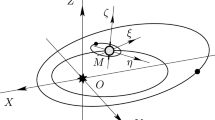Abstract
Differential equations describing the tidal evolution of the earth's rotation and of the lunar orbital motion are presented in a simple close form. The equations differ in form for orbits fixed to the terrestrial equator and for orbits with the nodes precessing along the ecliptic due to solar perturbations. Analytical considerations show that if the contemporary lunar orbit were equatorial the evolution would develop from an unstable geosynchronous orbit of the period about 4.42 h (in the past) to a stable geosynchronous orbit of the period about 44.8 days (in the future). It is also demonstrated that at the contemporary epoch the orbital plane of the fictitious equatorial moon would be unstable in the Liapunov's sense, being asymptotically stable at early stages of the evolution. Evolution of the currently near-ecliptical lunar orbit and of the terrestrial rotation is traced backward in time by numerical integration of the evolutional equations. It is confirmed that about 1.8 billion years ago a critical phase of the evolution took place when the equatorial inclination of the moon reached small values and the moon was in a near vicinity of the earth. Before the critical epoch t cr two types of the evolution are possible, which at present cannot be unambiguously distinguished with the help of the purely dynamical considerations. In the scenario that seems to be the most realistic from the physical point of view, the evolution also has started from a geosynchronous equatorial lunar orbit of the period 4.19 h. At t < t cr the lunar orbit has been fixed to the precessing terrestrial equator by strong perturbations from the earth's flattening and by tidal effects; at the critical epoch the solar perturbations begin to dominate and transfer the moon to its contemporary near-ecliptical orbit which evolves now to the stable geosynchronous state. Probably this scenario is in favour of the Darwin's hypothesis about originating the moon by its separation from the earth. Too much short time scale of the evolution in this model might be enlarged if the dissipative Q factor had somewhat larger values in the past than in the present epoch. Values of the length of day and the length of month, estimated from paleontological data, are confronted with the results of the developed model.
Similar content being viewed by others
References
Aleshkina, E. Yu., Krasinsky, G. A. and Vasilyev, M. V.: 1996, 'Analysis of LLR data by the program system ERA', In: Proc. IAU Coll. 166 Dynamics and Astrometry of Natural and Artificial Celestial Bodies, July 1–5, 1996, Poznan, Poland, 227–232.
Brouwer, D. and Clemence, J.: 1961, Methods of Celestial Mechanics, Academic Press, New York, London.
Burns, J. A.: 1980, Evolution of Orbital Motion. Planetary Satellites, University of Arizona press, Tucson, Arizona.
Cameron, A. G. W. and Benz, W.: 1991, 'The origin of the Moon and the single impact hypothesis IV', Icarus 92, 204–216.
Cameron, A. G. W.: 1996, 'The origin of the Moon and the single impact hypothesis V', Icarus 126, 126–137.
Canup, R. M. and Esposito, L. W.: 1996, 'Accretion of the Moon from an impact-generated disk', Icarus 119, 427–446.
Dickey, J. O., Bender, P. L., Faller, J. E., Newhall, X. X., Ricklefs, R. L., Ries, J. G., Shellus, P. J., Veillet, C., Whipple, A. L., Wiant, J. R., Williams, J. G. and Yoder, C. F.: 1994, 'Lunar laser ranging: a continuing legacy of the Apollo Program', Science 265(22 July), 482–490.
Goldreich, P.: 1965, 'Inclination of satellite orbits about an oblate precessing planet', Astron. J. 70(1), 5–9.
Goldreich, P.: 1966, 'History of the lunar orbit', Rev. Geophys. 4, 411–435.
Kaula, W. M.: 1971, 'Dynamical aspects of lunar origin', Rev. Geophys. Space. Phys. 9(2), 217–238.
Krasinsky, G. A.: 1999, 'Tidal effects in the earth–moon system and the earth rotation', Celest.Mech. & Dyn. Astr. 75(1), 39–66.
Lambeck, K.: 1978a, 'The earth's palaerotation', In: P. Broshe and J. Sündermann (eds), Tidal Friction and the Earth's Rotation, Springer, Berlin, Heidelberg, New York, pp. 144–153.
Lambeck, K.: 1978b, 'The history of the Earth's rotation', In: M. W. McElhinny (ed.), The Earth, its Origin, Structure and Evolution, Academic Press, London.
MacDonald, G. J. F.: 1964, 'Tidal friction', Rev. Geophys. 2, 467–541.
Mignard, F.: 1979, 'The evolution of the lunar orbit revisited, I', Moon Planets 20(3), 301–315.
Mignard, F.: 1980, 'The evolution of the lunar orbit revisited, II', Moon Planets 23(2), 185–201.
Néron de Surgy, O. and Laskar J.: 1997, 'On the long term evolution of the spin of the Earth', Astron. Astroph. 318, 975–989.
Mohr, R. E.: 1975, 'Measured periodicities of the Biwabik stromatolites and their geophysical significance', In: G. D. Rosenberg and S. K. Runcorn (eds), Growth Rhythms and the History of the Earth's Rotation, Wiley, London, pp. 43–55.
Morrison, L. V.: 1973, 'The secular accelerations of the moon's orbital motion and the earth's rotation', Moon 5, 253–264.
Panella, G.: 1972, 'Paleontological evidence on the Earth's rotational history since early Precambrian', Astrophys. Space Sci. 16, 212–237.
Sonett, C. P. and Chan, M. A.: 1998, 'Neoproterozoic earth–moon dynamics: rework of 900 Ma Big Cottonwood Canyon tidal laminae', Geophys. Res. Lett. 25(4), 539–542.
Touma, J. and Wisdom, J.: 1998, 'Resonances in the early evolution of the Earth–Moon system', Astron. J. 115(4), 1553–1653.
Williams, G. E.: 1997, 'Precambrian length of day and the validity of paleotidal values', Geophys. Res. lett. 29(1), 421–424.
Zeipel, H.: 1912, 'Entwicklung der Störungsfunction', Encykl. Math. Wiss. 6.
Zharkov, V. N.: 2000, 'On the history of the lunar orbit', Astronomichesky Vestnik 34(1), 3–14 (in Russian).
Author information
Authors and Affiliations
Rights and permissions
About this article
Cite this article
Krasinsky, G.A. Dynamical History of the Earth–Moon System. Celestial Mechanics and Dynamical Astronomy 84, 27–55 (2002). https://doi.org/10.1023/A:1019955827459
Issue Date:
DOI: https://doi.org/10.1023/A:1019955827459




